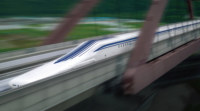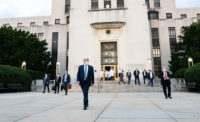A proposed $10-billion high-speed rail route between Baltimore and Washington, D.C. using magnetic levitation (maglev) is under fire from the Maryland city's officials, who cite its lack of detail, community impact and failure to align with current infrastructure upgrade plans in the corridor.
As part of its environmental review process, the Federal Railroad Administration is reviewing public comment on the Northeast Superconducting Magnetic Levitation (SCMAGLEV) project.
Chris D. Ryer, director of the Baltimore City Dept. of Planning, and Steve Sharkey, director of the city Dept. of Transportation, have recommended a “No Build Alternative” for the project, in a letter to the agency in response to its draft environmental impact statement.
“The City of Baltimore has several concerns with the [statement] related to equity, environmental justice, and community impacts." the officials said. "Additionally, the draft lacks a sufficient level of detail regarding current and future plans for the project which make a comprehensive analysis difficult. The proposed project is also not aligned with significant efforts underway to upgrade existing rail infrastructure in the corridor."
Ryer and Sharkey cited concerns about train system effects on their communities and environment, particularly noting the proposed Camden Yards and Cherry Hill stations. The officials wrote that the projected $60 ticket cost could “negate an affordable and alternate form of transportation to the average ... rider,” they wrote. It currently costs $6 for an Amtrak ticket between Washington D.C. and Baltimore.
A federal agency spokesperson told ENR that it is still considering all comments received in response to the environmental review process and that additional information is expected to be released later this year.
The comment period for draft EIS concluded on May 24.
Northeast Maglev Chairman and CEO Wayne Rogers said, in a statement, that the Maglev project "has strong support" in the Baltimore community, citing recent polling by Lake Research Partners that found 72% of city residents favor it, along with businesses, unions, religious organizations and community groups.
Rogers says the project “will create pathways to the middle class for many people in underserved communities” and career opportunities with sustainable wages, health insurance and apprenticeship training.
He acknowledged the city’s letter, but says his group is working to “clarify and address concerns" raised.
"Since receiving their letter, we have been working with both departments. We believe that all their concerns can be fully addressed and mitigated moving forward,” Rogers says.
The proposed high-speed rail line would include an intermediate stop at BWI Thurgood Marshall Airport. Traveling at a speed of 311 mph, it would complete the trip between Washington, D.C., and Baltimore in 15 minutes.
Rogers previously told a state legislative committee that $5 billion in funding will come from Japan, where high-speed trains using superconducting magnetic levitation technology have been in operation for several years.
In 2016, the Federal Railroad Administration awarded the state a $27.8-million grant to fund preliminary engineering and an analysis of potential routes.




Post a comment to this article
Report Abusive Comment